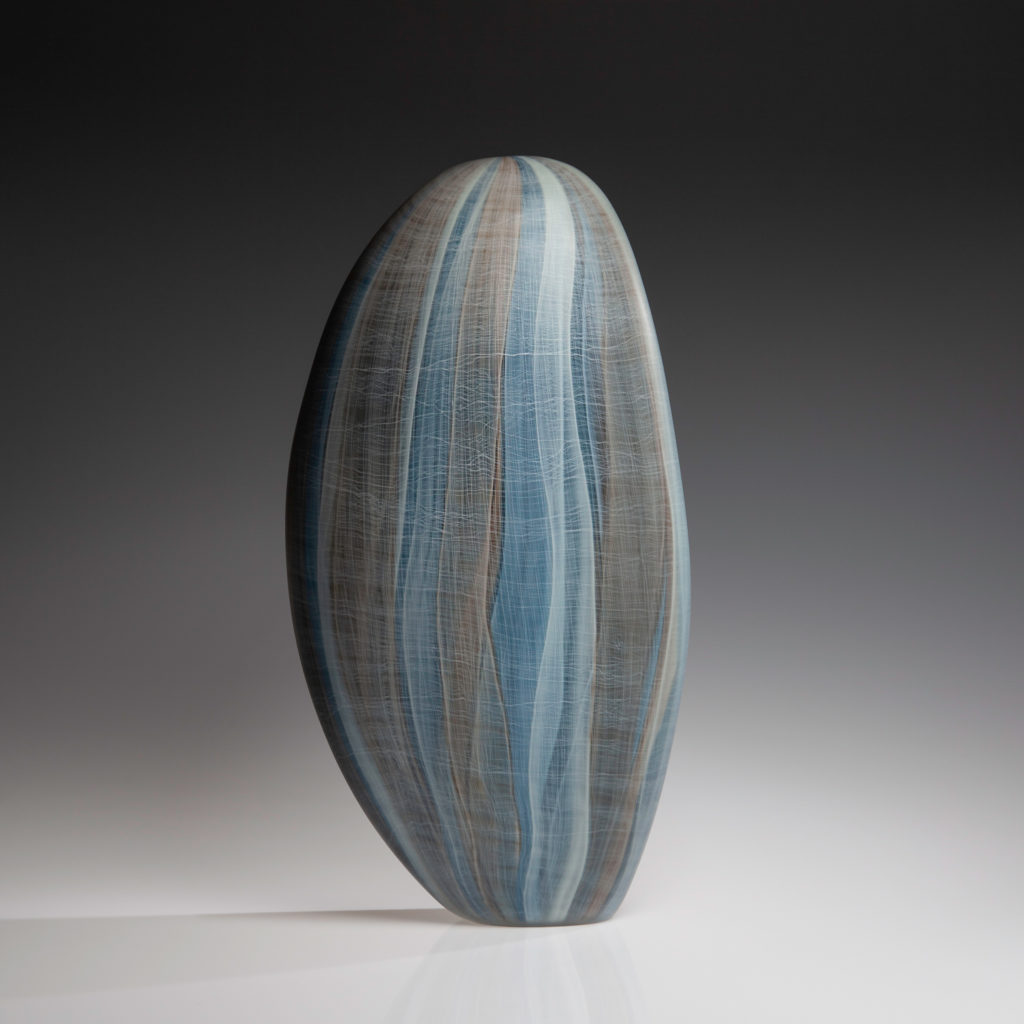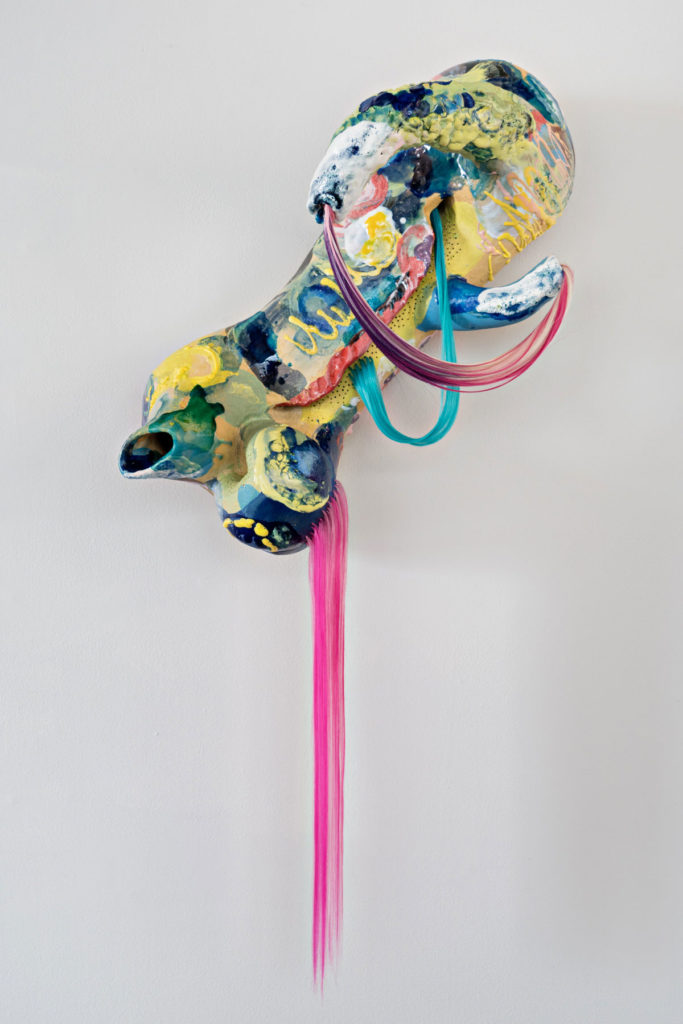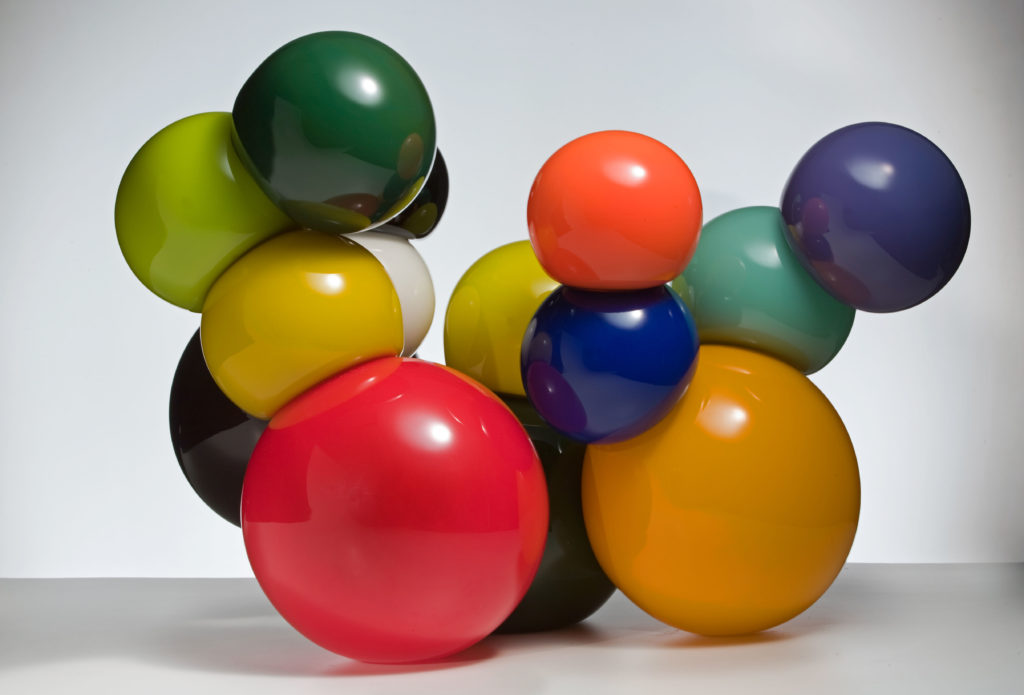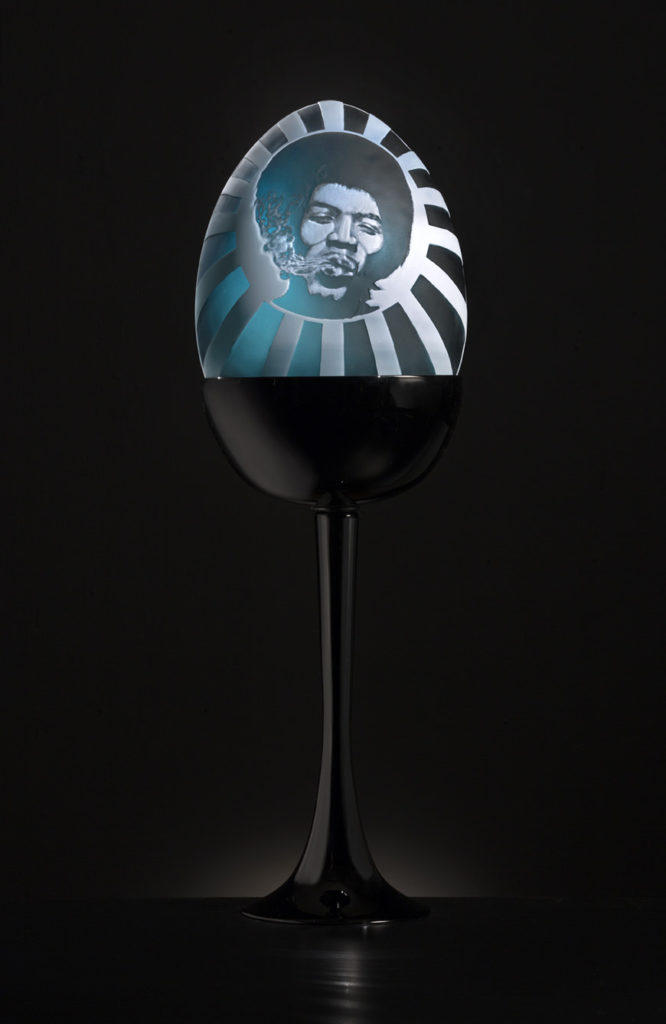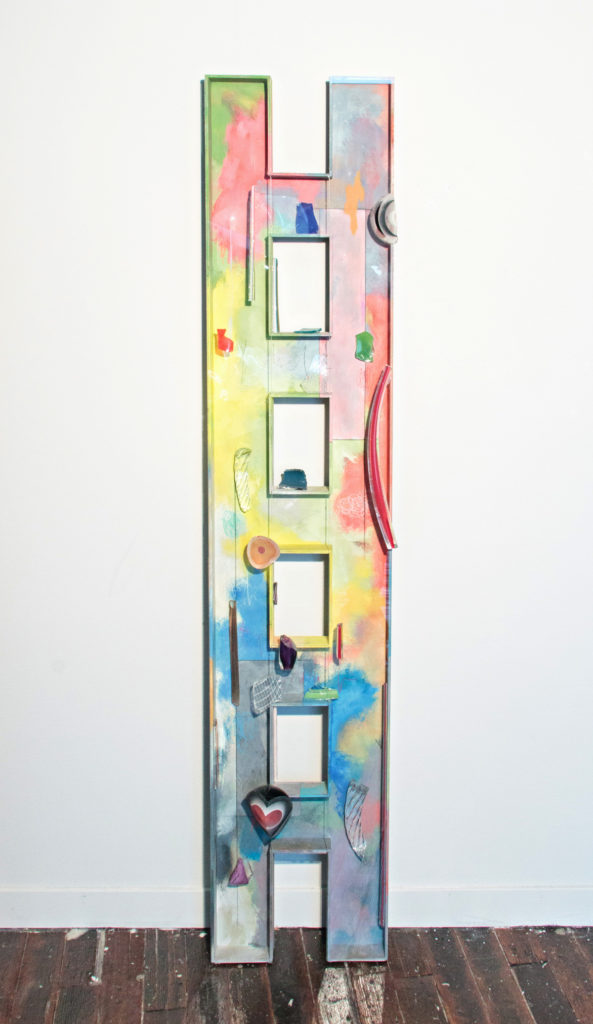Group Exhibition 2022

Traver Gallery is pleased to present the Gallery Artist Group Exhibition. This exhibition presents a curated selection of artworks from our roster of artists. Each artist in this exhibition explores materiality, technique, and concept through their chosen medium. The artists included are Clare Belfrage, Mark Bennion, Ling Chun, Jennifer Elek, Harold Hollingsworth, Paul Marioni, Morgan Peterson, Thermon Statom, Matthew Szosz, and Jamie Walker.
-
About
Clare Belfrage - view profile
Inspired by experiences in the natural world for many years now, Clare Belfrage has forged an international reputation for her distinguished work with detailed and complex glass drawing on blown glass forms.
She has maintained a vibrant practice for thirty years. She has been an active part of artists’ communities, particularly in Adelaide and Canberra, including the glass based studio blue pony, of which she is a founding member, the JamFactory Glass Studio in Adelaide and, Canberra Glassworks where she played the pivotal role of Creative Director from 2009 to 2013.
Clare has had a long involvement in education and has lectured in the glass programs at the University of South Australia, SA, and Ohio State University, USA and Curtin University, WA. She is currently an Adjunct Professor at the University of South Australia. She has also taught numerous workshops throughout Australia, New Zealand, Japan, and the United States.
In addition to Australia, Clare regularly exhibits in North America, Europe, Hong Kong, and New Zealand. Her work has been recognized for its innovation and originality and in 2005 and, 2011, she was awarded the Tom Malone Glass Prize by the Art Gallery of Western Australia. In 2016 she was awarded the inaugural FUSE Glass Prize for Australian and New Zealand glass. In 2018 Clare was the South Australian Living Artist Festival feature artist and subject of the festival’s annual monograph, Rhythms of Necessity, written by Kay Lawrence and Sera Waters.
Clare’s work is represented in major public collections including National Gallery of Australia, Canberra, Corning Museum of Glass, USA, Museo do Vidro, Marinha Grande, Portugal, Tacoma Museum of Glass, USA, National Art Glass Collection, Wagga Wagga, ArtBank, NSW, Art Gallery of South Australia, Art Gallery of Western Australia, Museum and Art Gallery of Tasmania and Northern Territory Museum.
-
Mark Bennion
- view profile
Seattle born Bennion is a painter and sculptor who has shown his work across the United States, Canada, and Europe since 1968. He lives and works on Vashon Island, near Seattle, Washington. Following in the tradition of Northwest artists such as Mark Tobey, Paul Horiuchi, Morris Graves and William Ivey, all of whom shared an affinity for painting on paper as well as a deep reverence for eastern art, Bennion sees his frescoes as a “confluence of eastern and western techniques and traditions.” Like the frescoes of Pompeii, Bennion’s paintings convey a sense of history and tradition. A practicing Buddhist for much of his adult life, Bennion is concerned more with the moment of inner peace and meditation, than with the specific story each painting or sculpture tells. His hopes are that the viewer finds great inspiration, or simply a moment of insight, in the work.
Strongly encouraged by mentor William Ivey (1919-1992), Bennion spent years developing his unique painting process, which he calls fresco — using oil paint, dry pigment on plaster and paper which is attached to a panel or canvas. This process lends itself to many of his interests; textures that recall ancient walls and decaying structures are overlaid with markings and shapes of the mythology from many cultures, creating a surface that is both familiar and unknown. The work on plaster is painted and sanded, and painted over and over, sometimes 4 or 5 layers but often up to 10 or 12 until the work is complete.
Bennion is also a sculptor; crafting mostly large scale geometric welded steel pieces and numerous outdoor installations. His painting and sculptures share a meditative and often poetic quality, a quality that beautifully reflects Bennion’s own philosophy and approach to making art.
-
Ling Chun
- view profile
I have a drive, a lust and greed for color.
My ceramic forms are “playgrounds for glaze,” and I like to challenge the rules and roles of ceramics by disassociating the material from its stereotypical or culturally accepted uses. Removing still-hot pieces from the kiln, I apply liquid glazes to the surface creating a sizzling sound and a haze of steam until the glaze sticks. It is an intuitive process that emerges through multiple firings and layers of glaze. The work is born of the spontaneous dripping, sliding, running, climbing and crawling that occurs; the movement of the material is my medium.
The use of hair—which I see as a metamorphosis of the clay—serves as an extension of the ceramic process and also transgresses the permanence of clay, resetting the boundaries of ceramics reflected by cultural standards. My work also addresses my transitional stage between multiple cultures and languages through the complex layering of materials onto my ceramic sculptures. I believe contemporary ceramics will serve as a latter-day artifact of our current acknowledgment of cultural identity. It is a material strongly connected with history but never limited just to its heritage—a new age of ceramics will be one where style is no longer restricted to the old forms.
Ultimately, I desire to invite others into my side of the spectrum and to learn and study about how ceramics is more than just clay.
-
Mel Douglas
- view profile
Mel Douglas is one of the most celebrated artists working in glass today. Douglas’s refined and detailed work employs a minimalist aesthetic along with considered mark-making to engage a dialogue of how line and form can define and defy our understanding of space and volume. Douglas’ work explores the potential, versatility, and flexibility of glass as a material for drawing, and with it, expands our view of glass as a sculptural medium.
In Douglas’s words, “objects and drawings are often thought of as two separate entities. my pieces explore and interweave the creative possibilities of this liminal space, where the form is not just a support for drawing; but a three-dimensional drawing itself. Using the unique qualities of the material and the rich potential of mark-making on and with glass, I am using line as a way to inform, define and enable dimensional space”.
Mel Douglas has worked as an independent studio artist since graduating from the Canberra School of Art, Australian National University, in 2000. In 2020 Douglas was awarded a Ph.d. for her practice-lead research investigating how we can understand studio glass through the aesthetics of drawing. In addition to winning the 2020 and 2014 tom Malone Prize- a prestigious award through which a work is acquired each year into the collection of the National Gallery of Western Australia – Douglas has received several major awards, including the Ranamok Glass Prize in 2002 and the International Young Glass Award in 2007 from the Ebeltoft Museum of Glass.
In 2019 her work was the inaugural acquisition for the Australian National Gallery of Art’s Robert and Eugenie Bell Decorative Arts and Design fund. Douglas’ work is held in the private collections and public institutions internationally, including the Corning Museum of Glass, The Chrysler Museum of Art, the Ebeltoft Museum of Glass, and the National Gallery of Australia.
-
Jen Elek
- view profile
Jen Elek received her BFA from Alfred University in Metal and Hot Glass sculpture in 1994, after training as a welder in Allentown, PA. She was a student of Michael Scheiner, Dante Marioni, and Ann Wahlstrom at Pilchuck Glass School, and studied with Lino Tagliapietra at Haystack Mountain School of Crafts. In addition to doing her own work, the Seattle-based Elek has assisted glass artists such as Dale Chihuly, Kiki Smith, Preston Singletary, Lino Tagliapietra, and others. A vibrant contemporary glass artist, Elek exhibits alongside artists of other mediums, breaking some of the barriers that have kept glass in the realm of craft and offering it as a worthy medium of contemporary art.
-
Harold Hollingsworth
- view profile
The work of Harold Hollingsworth is characterized by colorful eruptions, rich surfaces and rhythmic playfulness. The tossed off elements and poetic debris of our common modern environment influence on his work – weathered advertisements, paper flyers peeling off walls, fonts and moments of graphic abstraction in everyday life. In the past, he has used familiar images such as old road sign graphics, vintage and modern letter forms, along with numbers, crossed with natural and accidental forms found in nature. Recent works are more subtle translations of modernist forms that mirror graphics that are cut free of their original meaning.
A graduate of Western Washington University, Harold has also been shaped greatly by the teaching style and bravado of professor and artist, R. Allen Jensen. Harold showed with Galleria Potatohead and Linda Farris Gallery after graduating from Western Washington University in 1989. He has shown with Elizabeth Leach Gallery in Portland, Circa Gallery in Minneapolis and has been shown recently in residence at Takt – Berlin Germany.
A native of Seattle, Harold has presented 17 solo shows and participated in 38 group shows. His work resonates not only with individual collectors, but corporate investors as well. Approximately 25 Nordstrom stores around the country display Harold’s work. The Target Corporation, Twitter, and Hilton Hotels along with Swedish Hospital have work by Harold.
-
Therman Statom
- view profile
Therman Statom – sculptor, glass artist, and painter – is most notably known as a pioneer of the contemporary glass movement for his life-size glass ladders, chairs, tables, constructed box-like paintings, and small scale houses; all created through the technique of gluing glass plate together. Sandblasted surfaces become a canvas for spontaneous vibrant colors and line work, which take nuances from Abstract Expressionism and concepts of Minimalism, while simultaneously incorporating a twist by using blown-glass elements and found objects.
Born in Winter Haven, Florida in 1953, Statom spent his adolescence growing up in Washington, D.C. His interest in the arts grew from a fondness of painting and he began to investigate ceramics at RISD. However, after an experimental glass blowing session with Dale Chihuly, he was soon hooked on the spontaneity of glass blowing and its limitless possibilities. Statom went on to pursue studies at Pilchuck Glass School during its inaugural year, completing a BFA in 1974 from RISD, and later studied at the Pratt Institute of Art & Design.
Throughout his career, public artworks have been permanently installed at prominent locations including the Los Angeles Public Library, Corning, Inc. Headquarters, the Mayo Clinic, San Jose Ice Center, the Toledo Museum of Art, and the Jepson Center for the Arts in the Telfair Museum, Savannah as well as several hospitals across the country.
His artwork appears in numerous exhibitions annually, including solo and group shows around the nation and internationally. Over the span of his career, he has completed over thirty large, site- specific installations. Most notably in recent years, his 2009 solo exhibition “Stories of the New World,” at the Orlando Museum of Art, which spanned over 5,000 square feet, has been his largest installation to date. Exploring themes related to Juan Ponce de Leon’s 1513 search for the fabled Fountain of Youth as a point of departure, the installation referenced historic and contemporary themes of hope, discovery, ambition, and destiny. Visitors traversed the gallery space consisting of a mirrored maze, panoramic glass wall mural, a room-size structure built entirely of glass, and video projections. In conjunction with the exhibit, Statom partnered with the educational department of the OMA and the Zora Neale Hurston National Museum of Eatonville to work with over eighty young students to create a work of art titled, “Glass House”, which was a large, walk-though structure built from glass boxes designed by the children. The piece was later displayed at the annual summer community festival.
Much of the latter half of Statom’s career has been focused on the importance of educational programming within the arts. He has taken a deep interested in employing workshops as a catalyst for social change and in affect, positively impacting a community. Working directly with the artist himself, adults and children alike share a combined experience of exploring art making via a hands-on experience. Inhibitions and limitations are left by the wayside, and the practice or act of “doing” becomes a journey of self-discovery, creating an opportunity for the participant to go to a new place within themselves.
“I believe art can be understood both conceptually and intuitively. I think there is a need for the general public to come to an understanding that to appreciate art and creativity they must trust his or her self; that extensive education is not a prerequisite for understanding art. Much of what I do is seeded in what is more of an intuitive process; a large portion of my work is exploring these processes within people and their environments.
The fact is, I believe that creativity is a part of all aspects of what people do; my studio and educational efforts via workshops and the support of outside programming, general educational and cultural institutions, are a reflection of this belief.
I feel that art is tool for empowerment and education. It’s also a viable tool to investigate positive change and engage a culture through the use of exploration.”
-
Matthew Szösz
- view profile
Matthew Szösz is known for his innovative use of materials and developing new sculpting processes, as well as video work that documents the excitement of making.
Born in Rhode Island, Matthew Szösz has received 3 degress including a Masters in Glass from Rhode Island School of Design. He began producing his own work a decade ago, and has received several awards, including the Jutta Cuny-Franz, a Tiffany Foundation grant, and the Borowsky Prize. He has been an artist in residence at university and arts programs across the US, as well as Denmark, Japan and Australia, and has taught at Virginia Commonwealth University, University of Washington, Toyama, Penland, Pilchuck, Pittsburgh Glass Center, and Public Glass in San Francisco, where he was executive director. He has exhibited at the Renwick Gallery of the Smithsonian, the Boston Museum of Fine Arts, GlazenHuis (Belgium) and the Museum of Art and Design in NYC, among others.
In 2010 he founded Hyperopia Projects, curatorial/ project group based in the USA that advances cross-genre material based sculpture and critical thought. He currently lives and works with his wife, Anna Mlasowsky, in Seattle, WA.
“I am the child of two ideas. The first is the unreconstructed artisanship tradition in which I was raised. The second is the church of ecstatic blue collar Rock & Roll anarchy for which I volunteered. This is the territory that excites me- lying between the sensitive and considered restraint of learned technique and the manic populist energy of the rock throwing iconoclast, described by an wobbling elliptical oscillation between the two. Sophisticated, erudite ideas with feet of clay, a heedless headlong dive into complex and esoteric waters. The friction of these two has been my experience of life, the experience of living within the body and the mind at the same time, each correcting the other in ragged arrhythmia. The opposing pulls of intellect and emotion maintain a tense center that lives and vibrates with their energy.”
-
Morgan Peterson
- view profile
Morgan Peterson graduated from Massachusetts College of Art and Design in 2006. She is currently a member of Dale Chihuly’s glassblowing team and has been a teacher at the Pilchuck Glass School. She has exhibited her work internationally and was most recently included in the group exhibition at Traver Gallery, As In Also: An Alternative Too, curated by John Drury.
-
Jamie Walker
- view profile
Jamie Walker is a professor at the University of Washington where he holds the Wyckoff Milliman Endowed Chair of Art and was appointed Director of the School of Art + Art History + Design in 2014. He was the recipient of the University’s Distinguished Teaching Award in 2008. Walker studied at the University of Washington where he received a BA/History and a BFA/Ceramics before receiving his MFA at the Rhode Island School of Design. His work has been featured in 24 one-person exhibitions and numerous group exhibitions throughout the U.S. and Europe. Collections include the Seattle Art Museum, Henry Art Gallery, Racine Art Museum, International Museum of Glass, and the Museo del Vino, Torgiano Italy. Reviews of his work have appeared in Ceramics: Art and Perception, Sculpture, New Art Examiner, Ceramics Monthly and American Ceramics. In 2005 he was honored with a Flintridge Foundation Artist Grant and in 2010 completed a three-piece outdoor commission for Vulcan Inc., located at the Amazon headquarters in Seattle.
“My recent studio work has been directed by materiality, perception and chance and has included participatory installations, wall bowls and spherical accumulations rendered at both an intimate or large scale. I am intrigued by the plethora of ever shifting information, both real and imagined, that can be observed from watching clouds, viewing cellular structures, studying landscape paintings or taking a walk on the beach. I am interested in the metaphorical potential of exploiting the somewhat uncontrollable nature of the ceramic process with the conscious and technical control I try to exert with the glazed surfaces. These sources serve as gateways to my studio endeavors where I create work that eventually becomes stationary and permanent, but may still allow for an imaginative, even meditative, perceptual experience.”

